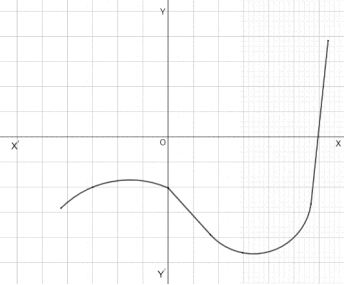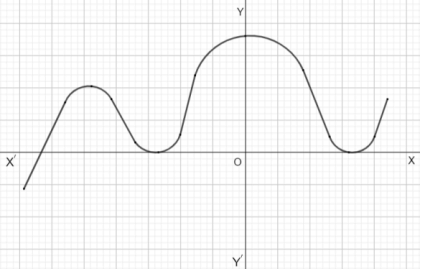NCERT Solutions for Class 10 Maths Chapter 2 Polynomials Exercise 2.1 - FREE PDF Download
NCERT Solutions for Class 10 Maths Chapter 2 Polynomials Ex 2.1
FAQs on NCERT Solutions for Class 10 Maths Chapter 2 Polynomials Ex 2.1
1. Where Can I find accurate and comprehensive NCERT Solutions for Class 10 Maths Chapter 2 Polynomials Exercise 2.1?
You can avail the most accurate and reliable NCERT Solutions for Class 10 Maths Chapter 2 Polynomials Exercise 2.1 on Vedantu. Vedantu is a leading online mentoring platform known to offer the best chapter-wise NCERT Solutions to help students in learning and exam preparation. You can refer to Class 10 Maths NCERT Solutions for Chapter 2 Polynomials Exercise 2.1 and other exercises online or download the free PDF of the same from Vedantu’s site. These solutions cover all the problems given in exercise solved by subject matter experts. The solutions are designed as per the latest NCERT guidelines and syllabus. If you are looking for NCERT Solutions for Class 10 Maths Chapter 2 Polynomials, Vedantu is a perfect choice.
2. How to learn Polynomials chapter of Class 10 Maths to get the top score in the subject?
The best way to learn any chapter of Class 10 Maths is to solve NCERT exercises questions enough number of times. Polynomials is an important chapter of Class 10 Maths to score well in Class 10 CBSE board exams. NCERT is the best resource to get a thorough understanding of the chapter. In case of any doubts in solving the exercises of Class 10 Maths Chapter 2 Polynomials, students can refer to Vedantu’s NCERT Solutions for the same. These well-curated solutions will help in scoring well in the Maths board exams. Students can refer to NCERT Solutions for Class 10 Maths Chapter 2 provided by experts and learn the chapter effectively.
3. Why must I refer to exercise-wise NCERT Solutions for Class 10 Chapter 2 Polynomials?
Chapter 2 Polynomials of Class 10 Maths explains the concepts of Polynomials in a detailed manner. To score well in exams, it is important to solve each question given in the NCERT textbook exercises of the chapter. NCERT Solutions for Class 10 CBSE Maths Polynomials Exercise 2.1 and other exercises are the most reliable online resource for students facing any doubt in the chapter. They can refer to the solutions provided by experts and clear all their doubts. These experts have years of experience in the field of teaching and are well versed in exam pattern and NCERT guidelines. NCERT Solutions are a great way to have a thorough understanding of the chapter’s exercises and achieve high scores in exams.
4. What will students learn from the first exercise of Chapter 2 polynomials of Class 10 Mathematics?
Through Exercise 2.1 of Chapter 2 Polynomials of Class 10 Maths, students will learn the geometrical representation of linear and quadratic polynomial and the geometrical meaning of the zeros of the polynomial. Students will be asked to find the number of zeros of p(x) for a given graph representing a polynomial. Students can refer to the NCERT Solutions for the exercise available on Vedantu. These solutions are provided by experts here.
5. What are the total number of questions in Exercise 2.1 Class 10 Maths?
There are in total six questions in Class 10 Maths Exercise 2.1. This exercise is the most important of all as it is the base of your algebraic understanding. In each question, there is a graph given with a variable of the highest value. You need to solve the polynomial equation and determine the number of zeros on the graph. You can take the help of quick tricks mentioned in NCERT Solutions to solve the questions quickly.
6. Why is the Class 10th Mathematics Chapter 2 important?
Chapter 2 Class 10 Maths is considered the most important chapter. As you will gain the understanding to solve polynomial equations, it will help you in further chapters as well. Understanding the graph and relating it to the given equation is very important as you will come across various questions in further chapters that will require the same knowledge. Hence, solve as many questions as you can to get a proper understanding of the concept.
7. What is the importance of understanding Polynomial equations?
Polynomials are one of the essential topics of Mathematics. You will be taught to relate numbers with variables. Variables do not have fixed values and their values can differ up to the highest possible numbers. Relating these variables with fixed numbers can help you to relate and understand many variable equations further in your studies. If you understand the concept of polynomials and how to show them on a graph, you can solve many equations easily.
8. How to determine the number of zeros of a given polynomial equation?
Polynomial equations have variables with the expected largest numbers as their values. Zero of a polynomial equation is the value where the graph of the equation intersects with the X-axis of the graph. To find the zeros of a polynomial equation for example P(x) is a polynomial equation, put P(x)=0 and solve for x.
9. Where can I find the downloadable solutions for NCERT Mathematics Class 10 Chapter 2 Exercise 2.1?
To find the solutions for Chapter 2 Exercise 2.1 Class 10 Mathematics, follow the under mentioned steps:
Click on the link NCERT Solutions for Class 10 Maths Chapter 2 Polynomials (Ex 2.1) Exercise 2.1 available on the Vedantu website(vedantu.com).
You will land on the Vedantu Solutions page for Class 10 Maths Chapter 2 Polynomials Exercise 2.1.
When you scroll down a little bit, you will see a link to download the PDF of the solutions.
Click on the link and you can download the file easily.
The solutions available are free of cost and also accessible on the Vedantu Mobile app.
10. How do you determine the degree of a polynomial class 10 maths ex 2.1?
In ex 2.1 class 10 the degree of a polynomial is the highest power of the variable in the expression. To determine the degree, look at the exponents of the variable in each term of the polynomial. The term with the largest exponent is the degree of the polynomial.
11. Why are zeros of a polynomial important in exercise 2.1 class 10 maths solutions?
In exercise 2.1 class 10 maths solutions zeros of a polynomial are important because they help in understanding the roots of polynomial equations and their graphs. Knowing the zeros allows us to determine the x-intercepts of the polynomial's graph, which is essential for graphing the function accurately. Additionally, zeros provide insight into the factors of the polynomial, aiding in the simplification and solution of polynomial equations. Understanding zeros is also key in solving real-world problems modeled by polynomials, such as in physics, engineering, and economics.
12. How can I find the zeros of a polynomial in class 10 ex 2.1?
In ex 2.1 class 10 to find the zeros of a polynomial, you need to set the polynomial equation to zero and solve for the variable. This involves finding the values of the variable that make the polynomial equal to zero. For example, if you have a polynomial you solve the equation to find the values. Methods such as factoring, using the quadratic formula, or graphing can be used depending on the degree and form of the polynomial.
13. Why is it important to classify polynomials by degree class 10 maths 2.1?
Classifying polynomials by degree is crucial because it helps in understanding the nature and behavior of the polynomial function. The degree of the polynomial determines the number of roots, the shape of the graph, and the end behavior of the polynomial. For instance, a quadratic polynomial (degree 2) will have at most two zeros and a parabolic graph, while a cubic polynomial (degree 3) will have at most three zeros and an S-shaped graph. Knowing the degree aids in selecting the appropriate method to solve and graph the polynomial equations accurately.
14. How can Vedantu’s solutions help me for class 10 maths ch 2 ex 2.1?
Vedantu’s solutions provide clear, step-by-step explanations that simplify complex concepts, making them easier to understand. The solutions are prepared by experienced teachers who follow the latest NCERT guidelines, ensuring that you get accurate and comprehensive answers. These solutions help you grasp the underlying principles, which enhances your problem-solving skills and boosts your confidence. Additionally, Vedantu offers downloadable PDFs, making it convenient for you to practice and revise anytime, ensuring effective preparation for your exams.




















 Watch Video
Watch Video





















